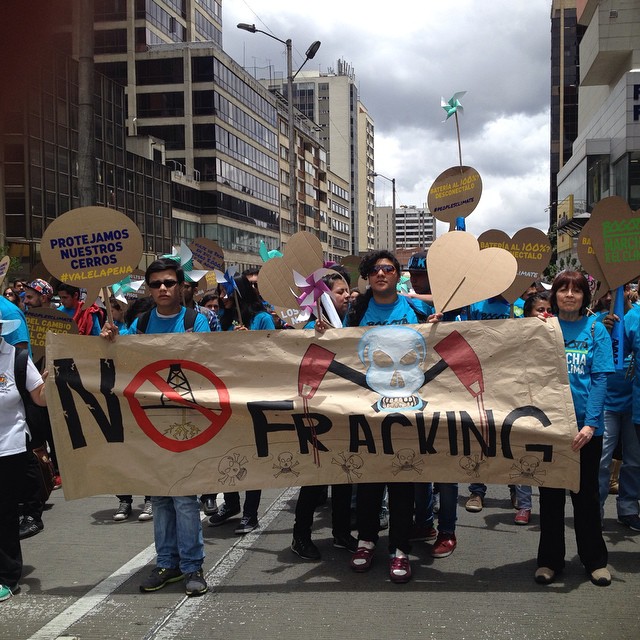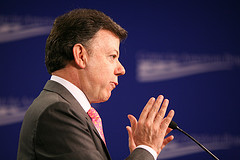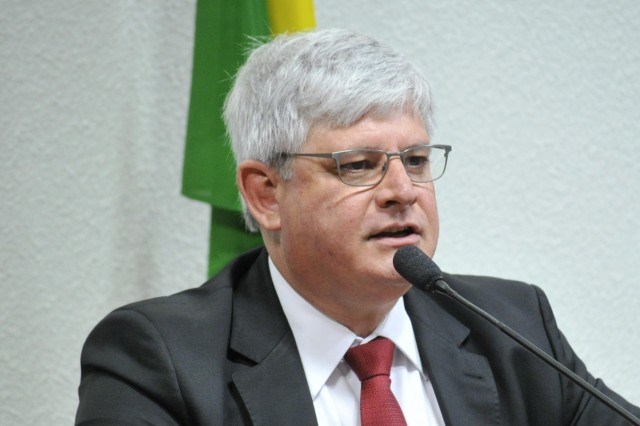
Andes, Argentina, Colombia, News Briefs, Southern Cone
Latin American Environmentalists Call For End To Fracking
December 12, 2014 By Camila Osorio
Latin American environmental activists called for an end to fracking this week, as international leaders gathered in Lima, Peru, for the United Nations summit on climate change.
Researchers and protestors from Mexico, Argentina, Brazil, Bolivia and Colombia met in Lima over the last two weeks to share their concerns about hydraulic fracturing, or “fracking,” in their countries, and released a public statement criticizing the practice on Monday supported by 71 environmental organizations.
“It is at the Conference of the Parties to the United Nations Framework Convention on Climate Change (COP 20) and the People’s Summit in Lima, we Latin-American civil society organizations warn about the irreversible impacts the extraction of non-conventional hydrocarbons will have through fracking,” the statement says. “We are making an urgent call to Latin American governments to stop the development of this activity in their territories and show their commitment to protecting the environment…. There are sustainable alternatives that are cheaper and more efficient, and guarantee respect for human rights, and these alternatives should be fostered by the states.”
Fracking is a method used by companies to extract gas or oil from layers of rocks within the earth. This method injects water at high pressures into the rock, mixed with sand and chemicals, which allows the gas or oil to flow out. This technology was introduced in the U.S. in the 1990s and has been celebrated for making the country energy independent.
But fracking has also been controversial in the U.S. because of the large amounts of water it requires, the dangerous chemicals it uses and the risk of small earthquakes it can cause after removing underground minerals. It has been banned in several U.S. towns because of these environmental concerns, including Danton, Texas, where fracking initially started.
Shannon Biggs, executive director of the U.S. environmental organization Global Exchange, said in Lima that fracking in the U.S. is “destroying lives, livelihoods, groundwater, rivers, farms, prairies, communities and landscapes” as was reported by The Guardian.
Despite the controversy around fracking, the technique is slowly making inroads Latin America. South America holds some of the largest reservoirs of natural gas in the world, according to a report published by the U.S. Energy Information Administration in 2013. The report also shows that Argentina, Mexico, and Venezuela contain some of the world’s most accessible shale oil and gas resources.
Until now, fracking has only developed in Argentina, but the governments of Mexico and Colombia are expected to start exploiting gas and oil trough this technique next year.
Francisco Cravioto is a Mexican researcher and spokesperson for the group Mexican Alliance Against Fracking, one of the organizations protesting in Lima right now.
Cravioto said the debate around fracking in Mexico is new, but it gained attention this year when President Enrique Peña Nieto approved an energy reform bill that ended the oil monopoly the public company Pemex had for decades.
Since Mexico is the world’s sixth-largest reserve of shale gas, according the U.S Energy Information Administration and Pemex has little experience in extracting it, many viewed the energy reform as an invitation for foreign companies to start fracking.
“Some of the people promoting fracking were telling us we could become the new Arab Emirates,” Cravioto said. The organization he is part of also has serious concerns regarding the water problems fracking could lead to in Mexico.
Water risk expert Paul Reig has been researching and mapping the risk of water stress in the 40 countries around the world where the largest reserves of shale gas are located. Water stress here refers to how water users are competing for limited supplies. The more users have to compete for water, the higher the stress.
Reig found that Mexico, a country that is estimated to have technically recoverable shale gas resources of 545 trillions cubic meters, has a very high risk of water stress if fracking is developed in the areas where the shale formations are located.
“There is enough information about the water risks Mexico could face,” Reid said. “The real question is if this information is going to be taken into consideration by private and public sector decision makers.”
Reid nevertheless thinks there are positive technological ways to frack, as long as the local geology, hydrology and socioeconomic situation are taken into account before starting shale exploitation.
Many opponents to fracking view the U.S. government as a driving force behind the practice’s promotion in Latin America. Reig said he was unaware of the U.S. government promoting shale development in foreign countries, but he had heard about the US “sharing the lessons learned in the past decade that could help other countries learn from the U.S. experience’ .
The U.S. government does share information about fracking through a State Department-led initiative called the Unconventional Gas Technical Engagement Program. According to the program’s website, it “uses government-to-government policy engagement to bring the U.S. federal and state governments’ technical expertise, regulatory experience and diplomatic capabilities to help selected countries understand their shale gas potential.”
The South Oil Observatory, a think tank based in Argentina that focuses on hydrocarbon exploitation, says in their latest book The 20 Myths and Realities of Fracking that the U.S. State Department program is the leading institution promoting fracking in Latin American countries. The book says the U.S. is not fully independent of oil and gas abroad yet, so it promotes fracking in friendly countries like Colombia and Mexico to avoid depending for energy on countries in the Middle East, Russia or Venezuela.
U.S. companies have also taken interest in countries like Argentina. The Argentine government expropriated Spanish multinational oil company Repsol S.A.’s 51 percent share in Argentine energy company YPF in 2012, renationalizing the company that had moved to Repsol S.A.’s hands in 1993. YPF, one of the biggest companies fracking in Argentina, has partnered with U.S. multinationals Chevron and Dow Chemical Corp.
Hernan Scandizzo is an Argentinean researcher at the South Oil Observatory and one of the authors of the book. According to him, after the Argentine government re-nationalized YPF, the company went looking for partners to exploit massive shale deposits in the country’s Southwest.
But Scandizzo says multinational companies conditioned their participation on a series of benefits that likely would have proven controversial in Argentina, like listing crude oil at international prices instead of the country’s lower internal price, or giving foreign partners greater control over the oil extracted.
The result was that multinationals found Mexico a more enticing investment opportunity, even before last year’s reform of the state oil company had been finalized, Scandizzo said.
“This makes it clear that the policy of promoting the exploitation of unconventional deposits has a regional scope,” Scandizzo said. “Argentina has been the platform to understand what fracking will be in Latin America.”
Argentina is the only Latin American country where fracking is at an advanced stage. There are at least 160 wells in the region of Vaca Muerta, according to “Albino Campo ‘Logko”, an indigenous leader of the Mapuche communities located there. They have traditionally lived in the region where fracking is being developed by Chevron and YPF, and have denounced their displacement and the environmental impacts in their land.
“The earth moves,” Campo told the Inter-Press News Service. “When fracking is being done, everything moves,”
YPF did not respond to a request for comment about the controversy over fracking, but company representatives told IPS last month that the seismic activity provoked by fracking is a 100,000 times less that what can be detectable by a human being and that the state hadn’t legally recognized the presence of Mapuche communities in the area. YPF says the company will only make use of 1 percent of the water in the province.
The other country in Latin America experiencing an intense debate over fracking is Colombia. The Colombian government approved fracking last September, arguing that it will apply strict environmental rules to the companies involved and, that revenue generated through fracking will finance education, anti-poverty programs and institutions for a post-conflict society if Colombia’s peace negotiations with the guerrilla group FARC are successful.
Julio Fierro, a Colombian geologist who has done research on fracking, says, “There is not enough research in Colombia about water resources to consider developing fracking in a cautious way.”
Fierro mentions how the U.S. government invited researchers who support fracking to the country.
“In 2012 the Colombian government was going to offer some areas to do fracking.” he said. “So we, at the National Audit offices [a public office regulating government policies in Colombia], warned the government about the impacts of fracking. The official warning alerted some oil companies who were concerned about the legality of fracking in Colombia. That’s when the government decided to bring gringos linked to the oil companies to explain the good uses of fracking.”
The news website La Silla Vacía made a list of the U.S. experts that visited Colombia to convince the government about the benefits of fracking.
“They talked about topics like properly using the wells where the water would be deposited, but they didn’t talk as much about pollution or the consequences in terms of seismicity,” Fierro said, referring to the risk of having more frequent earthquakes because of the rock removal necessary for fracking.
Among the visitors to Colombia was David Goldwyn, who worked at the State Department with Hillary Clinton as a special envoy and coordinator for international energy affairs. Goldwyn did not immediately respond to requests for comment on this story.
Drew Nelson, who worked for the U.S. State Department on climate negotiations and is now Senior Manager of an organization called the Environmental Defense Fund, said the U.S. and other government created a partnership with oil companies in the last U.N. meeting in September. This partnership is called the “Oil and Gas methane partnership”, and participants include companies interested in fracking like Pemex, Total, British Gas or South Western.
“The idea is to share experiences on how to reduce emissions from the oil and gas sector,” said Nelson, who also warned the release of methane in fracking and other sectors of the oil and gas supply chain can contribute to climate change. Although Nelson has a more positive vision of fracking production than Fierro, he also insists more scientific research is needed before starting fracking production.
“One thing that is important, that we didn’t do everywhere in the U.S., is having a baseline testing on water quality and air quality before hydraulic fracturing,” Nelson said. “That would have allowed us to compare, if it remained the same or worsened. That is why there is so much controversy in a state like Pennsylvania around methane, there wasn’t an initial test.”
But Tatiana Roa, a Colombian engineer, said the consequences of fracking extend beyond those limited concerns.
“But focusing just on methane reduction would be not contemplating the other consequences of fracking,” says Roa. “Like the consequences related to seismicity, or to water resources. The debate about fracking is not about counting just carbon emissions. This debate in Latin America and around the world is larger than that.”
Image: Laura Rico
About Camila Osorio
Camila is a Colombian reporter based in New York City. She has published her work in The New Republic, WNYC, PRI, the Colombian website La Silla Vacía, among others. She is currently checking facts at The New Yorker.
Next Article >





